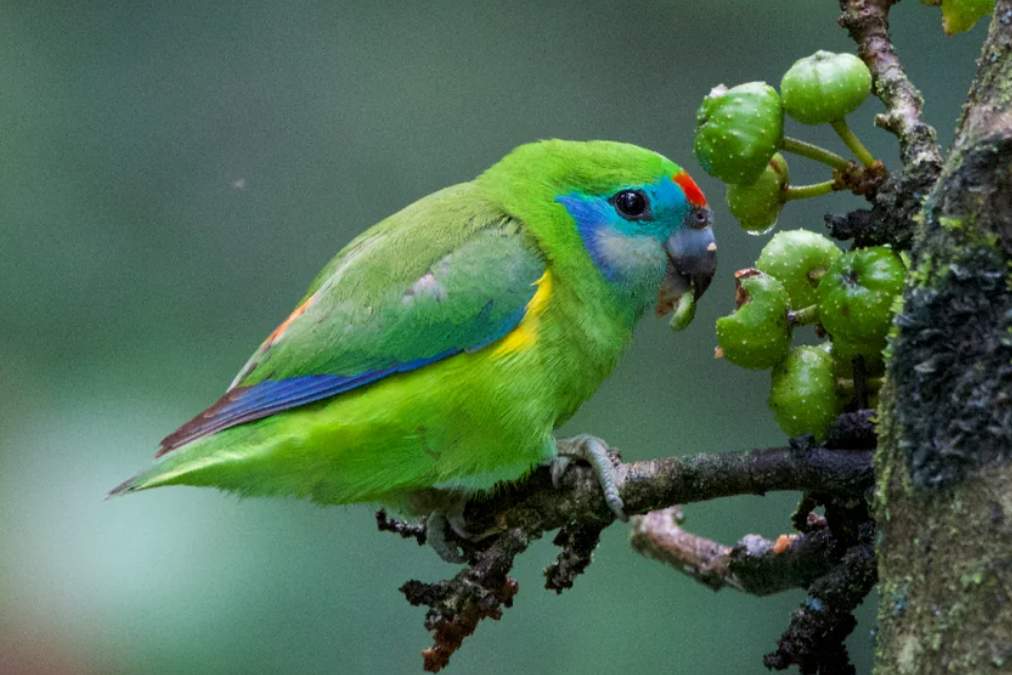The Australian King Parrot (Alisterus scapularis) is usually seen in pairs or small parties feeding among the outermost branches of forest trees, especially eucalypts and acacias. Australian parrots are famous for their beauty and natural color combinations that are endemic to eastern Australia. People love to keep them as pets. Occasionally, they are bred in aviaries and kept as quiet and calm pets in Australia if they are hand-reared.
They consume seeds, berries, fruits, nuts, nectar, blossoms, and leaf buds, but they also come to the ground to pick up fallen seeds, waddling awkwardly. When tearing large fruit to pieces with the bill to get at the kernels, they hold it on the left foot as they do with other parrots. It is unfortunate that these beautiful parrots raid orchards and maize fields, sometimes causing significant damage.
They also fly higher over the forest when traveling from and to their communal roost camps three or four hours after sunrise and sunset each day. There is often more difficulty approaching king parrots than rosellas since they are warier.

A disturbance causes them to take flight and call loudly. Its wingbeats are rhythmic and deliberate, but they weave their way through trees with remarkable agility, flying in a heavy, labored manner. A mature male King Parrot may associate with other uncolored birds when not breeding, but it is unclear whether they mate permanently. Both sexes do not groom each other.
Males display their scapular stripes on a perch, puff up their head feathers, draw up their bodies, blaze their colored iris, and give a harsh contact call in courtship. She continues to bobble her head in a similar manner to his to solicit food. Egg laying usually begins weeks in advance of feeding. The female incubates alone, but the male attends to her, feeding her intermittently and roosting nearby.
The Southern King Parrot, or King Lory, is another name for this bird. They can be very devoted pets even though they have limited “talking” abilities and generally don’t like to be handled. There is no information about the life expectancy of wild animals, but pet animals can live up to 25 years.
Including its long, thick tail, the Australian King Parrot measures about 420–430 mm in length. There is a scarlet color on the head and underparts of the male bird. Besides the dark green back and wings, the wing covers have a light green stripe. On the nape and lower back to the upper tail, there is a narrow blue band. Black is usually the color of the tail. An undertail with a broad scarlet band of green-black color covers it. A yellow ring surrounds the eyes, while a gray ring surrounds the outer ring. There are red tips on the upper mandible, black tips on the lower mandible, and gray feet with darker claws.
In contrast, the female Australian King Parrot has a deep green head, wings, and back, along with a light green stripe on its wing coverts. There is a green tint to the rump and lower back; the upper tail coverts are blue. Scarlet edges broadly outline the under-tail coverts. A dark emerald-colored central tail feather is paired with blue-green and pink-tipped outer tail feathers.
There is a red tinge to the upper throat and chest, which are dull green in color. There is a scarlet color on the belly and lower breast areas. With pale yellow eyes and a red-washed brown bill, this bird has pale yellow eyes. It is the same for females and males when it comes to their feet.
It is just like an adult female Australian King Parrot when it is immature. A pale covert stripe develops on the wings of older birds. After 16 months, males acquire adult plumage through a slow molt that lasts 14 to 15 months. Breeding has been observed in immature plumage. Downy young are Whitish-downed.
The call of the Australian King Parrot is in flight: a shrill crassak-crassak, repeated frequently. While perched, the bird utters a piping whistle, also apparently in contact. The nesting and breeding season lasts from September to January. In a large, deep hollow in the trunk of a tall tree, the bird builds its nest from decayed wood dust. Probably the bottom of the hollow is near the ground, and the entrance is more than 10 meters up.
The parrot lays 2 to 3, sometimes 4 or 5 eggs of white color, which are rounded in shape and have a size of 32–34 x 25–28 mm. It is the female who is responsible for incubation, which takes about 20–21 days. After hatching, both parents take on the responsibility of taking care of the young by feeding them. The chick leaves the nest about five weeks after hatching.
As far as distribution, the Australian King Parrot is common in heavily timbered mountain ranges and rainforests, from the Atherton Tableland south to eastern and southern Victoria. There are two races that exist in the tableland rainforest north of Townsville, one small and one medium. The other is a large range stretching from Rockhampton south to Victoria. The subspecies are known as A. s. minor and A. s. scapularis. Bell in southeastern Queensland has shown natural hybrids with the red-winged parrot (Aprosmictus erythropterus).
The identity of an isolated population ranges inland from Mackay, Queensland, to Port Campbell in Victoria. They inhabit the humid and heavily wooded uplands of the eastern part of the continent. Subtropical and temperate rainforests are adjacent to and in the vicinity of eucalyptus wooded areas.
Read More: Alexandra’s Parrot (Polytelis alexandrae)







